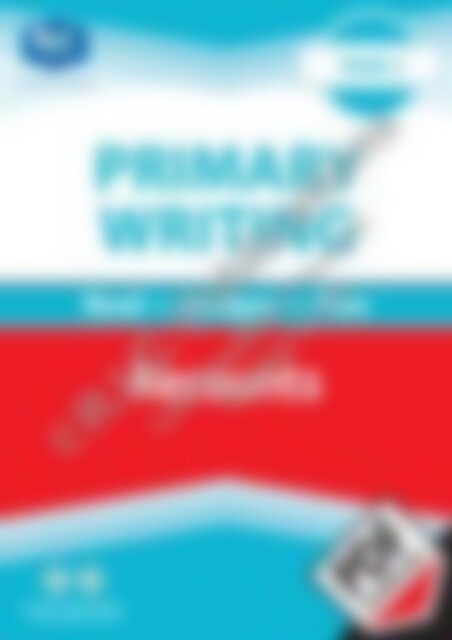RIC-20199 Primary Writing Year 3 – Recounts
Create successful ePaper yourself
Turn your PDF publications into a flip-book with our unique Google optimized e-Paper software.
©R.I.C. Publications<br />
Low Resolution Images<br />
Display Copy
PRIMARY WRITING (Book D)<br />
Revised and reprinted by R.I.C. Publications ® 2008<br />
Copyright © R.I.C. Publications ® 2006<br />
This master may only be reproduced by the<br />
original purchaser for use with their class(es). The<br />
publisher prohibits the loaning or onselling of this<br />
master for the purposes of reproduction.<br />
<strong>RIC</strong><strong>–</strong><strong>20199</strong><br />
Copyright Notice<br />
Blackline masters or copy masters are published and<br />
sold with a limited copyright. This copyright allows<br />
publishers to provide teachers and schools with a<br />
wide range of learning activities without copyright<br />
being breached. This limited copyright allows the<br />
purchaser to make sufficient copies for use within<br />
their own education institution. The copyright is not<br />
transferable, nor can it be onsold. Following these<br />
instructions is not essential but will ensure that you,<br />
as the purchaser, have evidence of legal ownership<br />
to the copyright if inspection occurs.<br />
For your added protection in the case of copyright<br />
inspection, please complete the form below. Retain<br />
this form, the complete original document and the<br />
invoice or receipt as proof of purchase.<br />
Name of Purchaser:<br />
Date of Purchase:<br />
Supplier:<br />
School Order# (if applicable):<br />
Signature of Purchaser:<br />
©R.I.C. Publications<br />
Low Resolution Images<br />
Display Copy<br />
Internet websites<br />
In some cases, websites or specific URLs may be recommended. While these are checked and rechecked at the<br />
time of publication, the publisher has no control over any subsequent changes which may be made to webpages.<br />
It is strongly recommended that the class teacher checks all URLs before allowing students to access them.<br />
View all pages online<br />
PO Box 332 Greenwood Western Australia 6924<br />
Website: www.ricgroup.com.au<br />
Email: mail@ricgroup.com.au
<strong>Primary</strong> writing<br />
BOOK D<br />
Foreword<br />
<strong>Primary</strong> writing is a series of seven books designed to provide opportunities for<br />
students to read, examine and write a variety of text types; narratives, recounts,<br />
procedures, reports, explanations and expositions.<br />
Contents<br />
Titles in this series:<br />
• <strong>Primary</strong> writing Book A • <strong>Primary</strong> writing Book E<br />
• <strong>Primary</strong> writing Book B • <strong>Primary</strong> writing Book F<br />
• <strong>Primary</strong> writing Book C • <strong>Primary</strong> writing Book G<br />
• <strong>Primary</strong> writing Book D<br />
Teachers notes........................................................................................iv <strong>–</strong> v<br />
Curriculum links ............................................................................................ v<br />
<strong>Writing</strong> format information.....................................................................vi <strong>–</strong> vii<br />
<strong>Writing</strong> format checklists.....................................................................viii <strong>–</strong> xiii<br />
Blank writing formats.......................................................................... xiv <strong>–</strong> xix<br />
Proofreading and editing checklist.............................................................. xx<br />
Class recording sheet .................................................................................xxi<br />
Narratives ................................................................................................................2<strong>–</strong>13<br />
1 <strong>–</strong> Trefin .................................................................................................. 2<strong>–</strong>5<br />
2 <strong>–</strong> Old Sultan .......................................................................................... 6<strong>–</strong>9<br />
3 <strong>–</strong> Hungry hill ...................................................................................... 10<strong>–</strong>13<br />
<strong>Recounts</strong> ..............................................................................................................14<strong>–</strong>25<br />
1 <strong>–</strong> Whistlestop tour ............................................................................. 14<strong>–</strong>17<br />
2 <strong>–</strong> Zoo visit ..........................................................................................18<strong>–</strong>21<br />
3 <strong>–</strong> Terror in the music room .................................................................22<strong>–</strong>25<br />
Procedures ..............................................................................................................26<strong>–</strong>37<br />
1 <strong>–</strong> Banana and choc chip muffins .......................................................26<strong>–</strong>29<br />
2 <strong>–</strong> Making a gas ..................................................................................30<strong>–</strong>33<br />
3 <strong>–</strong> Pinhole camera .............................................................................. 34<strong>–</strong>37<br />
Reports ..............................................................................................................38<strong>–</strong>49<br />
1 <strong>–</strong> Fairview Hockey Club .................................................................... 38<strong>–</strong>41<br />
2 <strong>–</strong> A new planet? ................................................................................ 42<strong>–</strong>45<br />
3 <strong>–</strong> Movie review .................................................................................. 46<strong>–</strong>49<br />
Explanations ..............................................................................................................50<strong>–</strong>61<br />
1 <strong>–</strong> ‘X’ marks the kiss ........................................................................... 50<strong>–</strong>53<br />
2 <strong>–</strong> A clever invention ........................................................................... 54<strong>–</strong>57<br />
3 <strong>–</strong> Pasta ............................................................................................. 58<strong>–</strong>61<br />
Expositions ..............................................................................................................62<strong>–</strong>73<br />
1 <strong>–</strong> The old drama hall ......................................................................... 62<strong>–</strong>65<br />
2 <strong>–</strong> Museum matters ............................................................................ 66<strong>–</strong>69<br />
3 <strong>–</strong> A dark and dull night ...................................................................... 70<strong>–</strong>73<br />
©R.I.C. Publications<br />
Low Resolution Images<br />
Display Copy<br />
PRIMARY WRITING<br />
R.I.C. Publications<br />
www.ricgroup.com.au<br />
iii
<strong>Writing</strong> format information<br />
Below are general descriptions of the text types included in this book.<br />
Report<br />
<strong>–</strong> is a framework which describes aspects of a<br />
living or non-living thing in detail<br />
<strong>–</strong> includes:<br />
• Title<br />
• Classification: a general or classifying<br />
statement<br />
• Description: accurate and detailed<br />
• Conclusion: a comment about the content<br />
of the report (optional)<br />
<strong>–</strong> uses the following language features:<br />
• factual language rather than imaginative<br />
• the third person<br />
• the timeless present tense<br />
• information organised into paragraphs<br />
A report may be written in the form of a book<br />
review, scientific report, newspaper or magazine<br />
article, eyewitness account or a progress report.<br />
Recount<br />
<strong>–</strong> is a framework which retells events as they<br />
happened in time order<br />
<strong>–</strong> may be factual, personal or imaginative<br />
<strong>–</strong> includes:<br />
• Title<br />
• Orientation: all relevant background (who,<br />
when, where, why)<br />
• Events: significant events in detail<br />
• Conclusion: often with an evaluative<br />
comment<br />
<strong>–</strong> uses the following language features:<br />
• vocabulary to suggest time passing<br />
• paragraphs to show separate sections<br />
• the past tense<br />
A recount may be written in the form of<br />
a newspaper report, diary, letter, journal,<br />
eyewitness account, biography, autobiography or<br />
history.<br />
Narrative<br />
<strong>–</strong> is a framework which tells a story<br />
<strong>–</strong> includes:<br />
• Title<br />
• Orientation: the setting, time and characters<br />
• Complication: involving the main character(s)<br />
and a sequence of events<br />
• Resolution: to the complication<br />
• Ending: often showing what has changed<br />
and what the characters have learnt<br />
<strong>–</strong> uses the following language features:<br />
• a range of conjunctions to connect ideas<br />
• appropriate paragraphing<br />
• descriptive language<br />
• usually written in past tense<br />
A narrative may be written in the form of a poem,<br />
story, play, imaginative story, fairytale, novel, myth,<br />
legend, ballad, science fiction story or modern<br />
fantasy.<br />
Procedure<br />
<strong>–</strong> is a framework which outlines how something is<br />
made or done<br />
<strong>–</strong> includes:<br />
• Title<br />
• Goal: the purpose of the procedure shown<br />
clearly and precisely<br />
• Materials: a list of materials or requirements<br />
under appropriate headings or layout<br />
• Steps: the method in a detailed, logical<br />
sequence<br />
• Test: an evaluation (if appropriate)<br />
<strong>–</strong> uses the following language features:<br />
• instructions often with an imperative verb<br />
• subject-specific vocabulary<br />
• simple present tense<br />
• concise language<br />
A procedure may be written in the form of a recipe,<br />
instructions for making something, an experiment,<br />
an instruction manual, a maths procedure, how to<br />
play a game, how to operate an appliance, how to<br />
use an atlas or how to deal with a problem.<br />
©R.I.C. Publications<br />
Low Resolution Images<br />
Display Copy<br />
vi<br />
R.I.C. Publications<br />
www.ricgroup.com.au<br />
PRIMARY WRITING
<strong>Writing</strong> format information<br />
Explanation<br />
<strong>–</strong> is a framework which outlines how something occurs,<br />
works or is made<br />
<strong>–</strong> includes:<br />
• Title<br />
• Statement: precisely what is to be explained<br />
• Explanation: a clear account in logical sequence of<br />
how and why the phenomenon occurs<br />
• Conclusion: an evaluation and comment about<br />
what has been explained<br />
OR<br />
• Title<br />
• a definition<br />
• a description of the components or parts<br />
• the operation—how it works or is made<br />
• the application—where and when it works or is<br />
applied<br />
• special features—interesting comments<br />
• evaluation or comment/conclusion<br />
<strong>–</strong> uses the following language features:<br />
• subject-specific terms and technical vocabulary<br />
where appropriate<br />
• simple present tense is often used<br />
• linking words to show cause and effect<br />
• information is organised into paragraphs<br />
An explanation may be written in the form of an essay, or<br />
a handbook—for example, how a kite works—a science,<br />
health or society and environment text.<br />
Exposition<br />
<strong>–</strong> is a framework which argues for a<br />
particular position and attempts to<br />
persuade the audience to share this<br />
view<br />
<strong>–</strong> includes:<br />
• Title<br />
• Overview: statement of the problem<br />
or issue and the writer’s position<br />
• Arguments: presented in a logical<br />
manner with supporting detail,<br />
usually from the strongest to the<br />
weakest<br />
• Conclusion: a restating of the<br />
writer’s position and a summary of<br />
the arguments presented<br />
<strong>–</strong> uses the following language features:<br />
• a variety of controlling and emotive<br />
words and conjunctions<br />
• paragraphs to state and elaborate on<br />
each point<br />
An exposition may be written in the form<br />
of an essay, a letter, policy statement,<br />
a critical review, an advertisement, an<br />
editorial or a speech.<br />
©R.I.C. Publications<br />
Low Resolution Images<br />
Display Copy<br />
Modelled writing<br />
The role of the teacher is to observe and support students as they develop as writers.<br />
<strong>Writing</strong> is an extremely complex activity, simultaneously involving decisions on content,<br />
text coherence and cohesion, spelling, grammar, punctuation and a sense of audience and<br />
purpose. Because it takes time and practice to develop understanding of the writing process<br />
and the different writing formats, many opportunities for students to interact with their teacher<br />
and their peers are essential.<br />
Modelled writing is an effective way of supporting student writers, particularly when the focus<br />
is on the cognitive processes involved.<br />
Frequent modelling of the planning process and how these plans can be used to write text in<br />
different formats, is strongly recommended.<br />
PRIMARY WRITING<br />
R.I.C. Publications<br />
www.ricgroup.com.au<br />
vii
Proofreading and editing checklist<br />
Name:<br />
Date:<br />
Title:<br />
Punctuation:<br />
I have included:<br />
capital letters for:<br />
Text type:<br />
beginning sentences.....................................................................................<br />
proper nouns.................................................................................................<br />
titles...............................................................................................................<br />
question marks.......................................................................................................<br />
full stops..................................................................................................................<br />
commas..................................................................................................................<br />
apostrophes:<br />
for grammatical contractions.........................................................................<br />
to show ownership........................................................................................<br />
exclamation marks..................................................................................................<br />
quotation marks......................................................................................................<br />
Spelling:<br />
I have:<br />
checked the spelling of any unknown words..........................................................<br />
not confused words that sound the same...............................................................<br />
used correct ending for plurals...............................................................................<br />
Language features:<br />
I have included:<br />
<strong>Writing</strong>:<br />
a variety of different verbs.......................................................................................<br />
correct verb tenses.................................................................................................<br />
appropriate adverbs to describe verbs...................................................................<br />
suitable nouns to name things, people, places and ideas......................................<br />
interesting adjectives in descriptions......................................................................<br />
suitable conjunctions to connect ideas...................................................................<br />
appropriate paragraphing.......................................................................................<br />
I have read through my writing to check that:<br />
©R.I.C. Publications<br />
Low Resolution Images<br />
Display Copy<br />
it makes sense........................................................................................................<br />
it is easy to understand...........................................................................................<br />
there are no repeated or omitted words..................................................................<br />
there are no errors of fact.......................................................................................<br />
xx<br />
R.I.C. Publications<br />
www.ricgroup.com.au<br />
PRIMARY WRITING
1 <strong>Recounts</strong><br />
TEACHERS NOTES<br />
Structural and language features are shown on the left and right of the text below.<br />
Title<br />
Orientation <strong>–</strong><br />
who, when, where, why<br />
Events <strong>–</strong><br />
in order with detail<br />
Conclusion <strong>–</strong><br />
indicating what has<br />
changed<br />
Teacher information<br />
Whistlestop tour<br />
Dear Grandma Alice<br />
I must tell you about the wonderful capital cities tour we did as part of our<br />
August holiday in Europe. Mum, Dad and I had the best time! We didn’t stay<br />
in any hotels because, after dinner each night, we took a train to the next<br />
city, arriving there early the following morning.<br />
Day 1: Amsterdam, Netherlands. Our first stop was Anne Frank’s house where<br />
she wrote her diary while she and her family were hiding from the Germans.<br />
It was so sad. Mum and I both cried. Dad was very quiet too. After lunch,<br />
we visited the Van Gogh museum. Did you know he was Amsterdam’s most<br />
famous artist? Later on, we went to the Bloemenmarkt, a world famous<br />
floating flower market. The flowers were stunning but we didn’t think it was a<br />
good idea to buy any!<br />
Day 2: Brussels, Belgium. In the morning, we strolled through the Grand Place,<br />
a 13th century market. I loved the medieval Town Hall with its crooked spire,<br />
topped with a statue of archangel St Michael slaying the devil! At midday,<br />
we joined a tour around the Royal Palace before enjoying a relaxing picnic<br />
lunch in Brussels Park. Dad and I both fell asleep while Mum read her book.<br />
Our last visit of the day was to Mini Europe, which has 300 doll-sized versions<br />
of Europe’s most famous monuments. It was so cool!<br />
Day 3: Paris, France. In the morning, we climbed the Eiffel Tower. The view<br />
of the city was amazing! Later on, we took a boat trip on the River Seine,<br />
followed by a drive along the famous Champs Elysee, and then passed the<br />
Arc de Triomphe, where the Tour de France finishes each year. We ended the<br />
day by attending a service at the Sacré-Coeur Church.<br />
Day 4: Vienna, Austria. Our last day! In the morning, we wandered around<br />
Marie Antoinette’s childhood home, the Schonbrunn Palace. It’s quite<br />
magnificent. We lazed in the gardens for a while before going to the Spanish<br />
Riding School to see the Lipizzaner horses practising their dressage. Then after<br />
dinner, it was off to the airport!<br />
Well, Grandma, we’re back home now and I’m busy with my diary and<br />
photographs because I’m writing a book about my holiday. I’ve collected<br />
lots of maps and leaflets from the places we visited. I’ve never enjoyed a<br />
holiday so much! When I grow up, I want to travel the world!<br />
With love from Sally<br />
• Discuss what a recount is, explaining that a letter is only<br />
one example.<br />
• Read and discuss the recount on page 15 with the students.<br />
• Identify the different sections and ensure students<br />
understand how the text fits into each one.<br />
• Emphasise the language features listed to the right of the<br />
text above.<br />
• Work through the analysis on page 16 with the students.<br />
• Plan a similar recount, writing ideas for each section within<br />
the framework and discuss and model how the plan is<br />
transformed into a coherent piece of text.<br />
• Students use page 17 to plan and then write a recount in<br />
the form of a letter to a friend about a holiday experience.<br />
• Students collect pictures and photographs of the places<br />
they visited, using them as a background for displaying their<br />
letters. (Display)<br />
• In a small authors circle, students read their letters, giving<br />
a brief description of their holiday destination. (Purpose/<br />
Audience)<br />
Answers<br />
Page 16<br />
1. Teacher check<br />
• appropriate<br />
paragraphing<br />
• vocabulary<br />
to suggest<br />
passing of<br />
time; e.g. In<br />
the morning,<br />
Later on<br />
• past tense;<br />
e.g. went,<br />
strolled<br />
©R.I.C. Publications<br />
Low Resolution Images<br />
Display Copy<br />
2. (a) Capital cities tour<br />
(b) Europe<br />
(c) Dad, Mum, Sally<br />
(d) By train<br />
3. (a) (i) 3 (ii) 6 (iii) 2 (iv) 5 (v) 4 (vi) 1<br />
(b) Answers may include: after dinner, after lunch, later on,<br />
in the morning, at midday<br />
4. She is writing a book about her holiday and wants to travel<br />
the world when she’s older.<br />
14<br />
R.I.C. Publications<br />
www.ricgroup.com.au<br />
PRIMARY WRITING
Whistlestop tour<br />
Recount 1<br />
Dear Grandma Alice<br />
I must tell you about the wonderful capital cities tour we did as part of our August<br />
holiday in Europe. Mum, Dad and I had the best time! We didn’t stay in any hotels<br />
because, after dinner each night, we took a train to the next city, arriving there early<br />
the following morning.<br />
Day 1: Amsterdam, Netherlands. Our first stop was Anne Frank’s house where she<br />
wrote her diary while she and her family were hiding from the Germans.<br />
It was so sad. Mum and I both cried. Dad was very quiet too. After lunch,<br />
we visited the Van Gogh museum. Did you know he was Amsterdam’s most<br />
famous artist? Later on, we went to the Bloemenmarkt, a world famous<br />
floating flower market. The flowers were stunning but we didn’t think it was<br />
a good idea to buy any!<br />
Day 2: Brussels, Belgium. In the morning, we strolled through the Grand Place, a<br />
13th century market. I loved the medieval Town Hall with its crooked spire,<br />
topped with a statue of archangel St Michael slaying the devil! At midday, we<br />
joined a tour around the Royal Palace before enjoying a relaxing picnic lunch<br />
in Brussels Park. Dad and I both fell asleep while Mum read her book. Our<br />
last visit of the day was to Mini Europe, which has 300 doll-sized versions of<br />
Europe’s most famous monuments. It was so cool!<br />
Day 3: Paris, France. In the morning, we climbed the Eiffel Tower. The view of the<br />
city was amazing! Later on, we took a boat trip on the River Seine, followed<br />
by a drive along the famous Champs Elysee, and then passed the Arc de<br />
Triomphe, where the Tour de France finishes each year. We ended the day by<br />
attending a service at the Sacré-Coeur Church.<br />
Day 4: Vienna, Austria. Our last day! In the morning, we wandered around Marie<br />
Antoinette’s childhood home, the Schonbrunn<br />
Palace. It’s quite magnificent. We lazed in<br />
the gardens for a while before going to the<br />
Spanish Riding School to see the Lipizzaner<br />
horses practising their dressage. Then after<br />
dinner, it was off to the airport!<br />
Well, Grandma, we’re back home now and I’m busy<br />
with my diary and photographs because I’m writing<br />
a book about my holiday. I’ve collected lots of maps<br />
and leaflets from the places we visited. I’ve never<br />
enjoyed a holiday so much! When I grow up, I want<br />
to travel the world!<br />
With love from Sally<br />
©R.I.C. Publications<br />
Low Resolution Images<br />
Display Copy<br />
PRIMARY WRITING R.I.C. Publications www.ricgroup.com.au 15
Use the recount on page 15 to complete the page.<br />
1. Title<br />
(a) Do you think the title tells you<br />
about the content of the letter?<br />
yes no<br />
(b) If you answered yes, explain why.<br />
If you answered no, suggest two<br />
alternative titles.<br />
3. Events<br />
(a) Label the attractions in the order they<br />
were visited. Start with number one.<br />
Examining recount 1<br />
2. Orientation<br />
Match the answers to the<br />
questions.<br />
(a) What? • • Dad,<br />
Mum<br />
Sally<br />
(b) Where? • • By train<br />
(c) Who? • • Capital<br />
cities<br />
tour<br />
(d) How? • • Europe<br />
(i) Mini Europe (ii) Schonbrunn Palace<br />
(iii) Bloemenmarkt<br />
(v) Eiffel Tower<br />
(iv) Sacré-Coeur Church<br />
(vi) Van Gogh museum<br />
©R.I.C. Publications<br />
Low Resolution Images<br />
Display Copy<br />
(b) Write three words or phrases from the text that suggest the passing<br />
of time.<br />
4. Conclusion<br />
What information does the conclusion give us about how much Sally<br />
enjoyed her holiday?<br />
16<br />
R.I.C. Publications<br />
www.ricgroup.com.au<br />
PRIMARY WRITING
Recount plan 1<br />
1. Plan a recount in the form of a letter to a friend about your holiday.<br />
Title<br />
Orientation<br />
Events<br />
Conclusion<br />
©R.I.C. Publications<br />
Low Resolution Images<br />
Display Copy<br />
2. Write your recount. 3. Edit your work.<br />
PRIMARY WRITING R.I.C. Publications www.ricgroup.com.au 17
2 <strong>Recounts</strong><br />
TEACHERS NOTES<br />
Structural and language features are shown on the left and right of the text below.<br />
Title<br />
Orientation <strong>–</strong><br />
who, when, where, why<br />
Events <strong>–</strong><br />
in order with detail<br />
Conclusion <strong>–</strong><br />
indicating value of<br />
event<br />
Teacher information<br />
Zoo visit<br />
Last week, <strong>Year</strong> 4 students visited the city zoo as part of their class project<br />
on animals of the world. Accompanied by their teachers and some parent<br />
helpers, the students enjoyed a bright spring day.<br />
On arrival, the students headed straight for the animals of the African<br />
savanna, knowing that many of the animals would be asleep in the<br />
afternoon. They were enchanted to see the week-old giraffe as it frolicked<br />
on its spindly legs.<br />
About mid-morning, feeding time for the otters created much amusement.<br />
The beautiful, sleek creatures delighted their audience, performing skilful<br />
swimming and diving antics as they waited impatiently to be fed.<br />
Students had to protect their ears as they followed the cries of the<br />
screeching monkeys. They had great fun recognising similarities between<br />
these likeable creatures and their friends!<br />
The last stop before lunch was the penguin pool. The cute flightless birds<br />
fascinated everyone as they lumbered awkwardly on land yet swam so<br />
swiftly in the water.<br />
A well-earned rest and a packed lunch quickly revived everyone. Time on<br />
the playground equipment was followed by a game of T-ball before carrying<br />
on with the animal tour.<br />
It was hard to keep track of individual meerkats as they suddenly dived<br />
underground in one place only to reappear moments later somewhere else.<br />
As the afternoon cooled, the students began to feel weary. But they found<br />
their last stop, the bird sanctuary, very exciting. They enjoyed the vast number<br />
of bird species and the brilliant colours of their plumage. It seemed that<br />
every possible combination of size and colour could be seen.<br />
Climbing on to the bus, exhausted but happy, everyone agreed the day<br />
had been a huge success. The students had seen their favourite animals and<br />
each had chosen one to study in detail for a project.<br />
• Discuss what a recount is, explaining that this magazine<br />
report is about a class excursion.<br />
• Read and discuss the recount on page 19 with the students.<br />
• Identify the different sections and ensure students<br />
understand how the text fits into each one.<br />
• Emphasise the language features listed to the right of the<br />
text above.<br />
• Students complete the analysis on page 20.<br />
• Plan a similar recount, writing ideas for each section within<br />
the framework and discuss and model how the plan is<br />
transformed into a coherent piece of text.<br />
• Students use page 21 to plan and then write a recount in<br />
the form of a magazine or newspaper story.<br />
• Students present their work as a class magazine or<br />
newspaper, giving each story an appropriate eye-catching<br />
title and illustration. A copy of the publication could be<br />
printed for other classes. (Publishing/Purpose/Audience)<br />
• A montage of photographs and pictures could be made to<br />
highlight a display of students’ work. (Display)<br />
Answers<br />
Page 20<br />
1. Teacher check<br />
2. (a) yes<br />
(b) yes<br />
(c) yes<br />
• appropriate<br />
paragraphing<br />
• vocabulary<br />
to suggest<br />
passing of<br />
time; e.g. last<br />
week, on<br />
arrival<br />
• past tense;<br />
e.g. were<br />
enchanted,<br />
revived<br />
©R.I.C. Publications<br />
Low Resolution Images<br />
Display Copy<br />
(d) no<br />
3. (a) Answers may include: last week, on arrival, about midmorning,<br />
before lunch, as the afternoon cooled<br />
(b) Teacher check<br />
(c) Teacher check<br />
4. Teacher check<br />
18<br />
R.I.C. Publications<br />
www.ricgroup.com.au<br />
PRIMARY WRITING
Last week, <strong>Year</strong> 4 students visited the<br />
city zoo as part of their class project on<br />
animals of the world. Accompanied by<br />
their teachers and some parent helpers,<br />
the students enjoyed a bright spring<br />
day.<br />
On arrival, the students headed straight<br />
for the animals of the African savanna,<br />
knowing that many of the animals<br />
would be asleep in the afternoon. They<br />
were enchanted to see the week-old<br />
giraffe as it frolicked on its spindly legs.<br />
About mid-morning, feeding time for<br />
the otters created much amusement.<br />
The beautiful, sleek creatures delighted<br />
their audience, performing skilful<br />
swimming and diving antics as they<br />
waited impatiently to be fed.<br />
Students had to protect their ears<br />
as they followed the cries of the<br />
screeching monkeys. They had great<br />
fun recognising similarities between<br />
these likeable creatures and their<br />
friends!<br />
Zoo visit<br />
Recount 2<br />
The last stop before lunch was the<br />
penguin pool. The cute flightless birds<br />
fascinated everyone as they lumbered<br />
awkwardly on land yet swam so swiftly<br />
in the water.<br />
A well-earned rest and a packed lunch<br />
quickly revived everyone. Time on the<br />
playground equipment was followed<br />
by a game of T-ball before carrying on<br />
with the animal tour.<br />
It was hard to keep track of individual<br />
meerkats as they suddenly dived<br />
underground in one place only to<br />
reappear moments later somewhere<br />
else.<br />
As the afternoon cooled, the students<br />
began to feel weary. But they found<br />
their last stop, the bird sanctuary, very<br />
exciting. They enjoyed the vast number<br />
of bird species and the brilliant colours<br />
of their plumage. It seemed that every<br />
possible combination of size and colour<br />
could be seen.<br />
Climbing on to the bus, exhausted<br />
but happy, everyone agreed the day<br />
had been a huge success.<br />
The students<br />
had seen<br />
their favourite<br />
animals and<br />
each had<br />
chosen one to<br />
study in detail<br />
for a project.<br />
©R.I.C. Publications<br />
Low Resolution Images<br />
Display Copy<br />
PRIMARY WRITING R.I.C. Publications www.ricgroup.com.au 19
Use the recount on page 19 to complete the page.<br />
1. Title<br />
Examining recount 2<br />
The title describes the text but it is not very inspiring. Suggest an<br />
alternative.<br />
2. Orientation<br />
Are all of these question answered in the first paragraph?<br />
(a) Who went to the zoo?<br />
(c) Why did they go?<br />
3. Events<br />
(a) Write three phrases from the<br />
text which show the passing of<br />
time.<br />
4. Conclusion<br />
yes no yes no<br />
(b) When did they go?<br />
(d) How did they get<br />
there?<br />
(c) Suggest a phrase to show the passing of time in each paragraph.<br />
visiting the monkeys<br />
lunchtime<br />
climbing on the bus<br />
(a) Do you think the concluding paragraph has a link<br />
with the orientation paragraph?<br />
(b) Explain your answer.<br />
(b) Which event took<br />
place at each of<br />
these times?<br />
©R.I.C. Publications<br />
Low Resolution Images<br />
Display Copy<br />
yes<br />
no<br />
20<br />
R.I.C. Publications<br />
www.ricgroup.com.au<br />
PRIMARY WRITING
Recount plan 2<br />
1. Plan a recount in the form of a magazine or newspaper story.<br />
Title<br />
Orientation<br />
Events<br />
Conclusion<br />
©R.I.C. Publications<br />
Low Resolution Images<br />
Display Copy<br />
2. Write your recount. 3. Edit your work.<br />
PRIMARY WRITING R.I.C. Publications www.ricgroup.com.au 21
3 <strong>Recounts</strong><br />
TEACHERS NOTES<br />
Structural and language features are shown on the left and right of the text below.<br />
Title<br />
Orientation <strong>–</strong><br />
who, when, where, why<br />
Events <strong>–</strong><br />
in order with detail<br />
Conclusion <strong>–</strong><br />
indicating value of<br />
event<br />
Teacher information<br />
Terror in the music room<br />
Thursday 23 February<br />
Never again! That was the last music exam I shall ever, ever take! No-one will<br />
ever make me change my mind. I don’t think I even want to touch my flute<br />
again. I have never been so humiliated in my entire life.<br />
It all started during the rehearsal in the main hall, just before I went into<br />
the music room. Mr Saunders, the accompanist, was very grumpy with me,<br />
treating me like a three-year-old. I’m ten, for goodness sake! Couldn’t he<br />
see that! I was practising my scales and arpeggios when the giggling first<br />
started. I lost my concentration, so Mr Saunders tut-tutted. More giggling<br />
and sniggering. Who was it? I had no idea. As I played my pieces, the loud<br />
laughing started and from the corner of my eye I saw James and Anthony<br />
from my class, running out of the hall. By now, Mr Saunders had lost all<br />
patience with me. He picked up his manuscript and swept into the music<br />
room. I waited nervously for my name to be called.<br />
As I stepped into the room, the examiner greeted me warmly, telling me not<br />
to worry, to take my time and relax. Mr Saunders tutted again and raised his<br />
eyes. He began to play. I raised the flute to my mouth but I couldn’t blow.<br />
Tears welled in my eyes and I started to choke. Mr Saunders began again,<br />
pounding the keys in annoyance. I tried to play. It didn’t sound like music at<br />
all, more like the yowling of an angry cat. I was sobbing as I played. I could<br />
barely read the music through my tears.<br />
Just when I thought it couldn’t get any worse, James and Anthony appeared<br />
at the window, pulling faces and pretending to cry. That was it for me!<br />
I garbled an apology and rushed out of the room in tears.<br />
<strong>Writing</strong> this has made me feel calmer. I didn’t fail that exam because I can’t<br />
play the flute, I failed because I allowed two no-hopers and a grumpy man<br />
get to me! First thing tomorrow, I’m going straight to my music teacher to ask<br />
for a repeat exam. This time, I’ll play so well, I’ll pass with distinction!<br />
• Discuss what a recount is, explaining that a diary entry is<br />
only one example.<br />
• Read and discuss the recount on page 23 with the students.<br />
• Identify the different sections and ensure students<br />
understand how the text fits into each one.<br />
• Emphasise the language features listed to the right of the<br />
text above.<br />
• Work through the analysis on page 24 with the students.<br />
• Plan a similar recount, writing ideas for each section of<br />
the framework and discuss and model how the plan is<br />
transformed into a coherent piece of text.<br />
• Students use page 25 to plan and then write a recount in<br />
the form of a diary entry.<br />
• Students handwrite their entries, with appropriate<br />
illustrations around the edge of the page. (Publishing)<br />
• In groups of five, over one week, students take turns to read<br />
their diary entries. (Purpose/Audience)<br />
• As each student reads his/her work, it is displayed for all to<br />
read. (Display)<br />
• Each day, the entries can be replaced, putting those from<br />
the previous day on a large sheet. At the end of the week,<br />
the five sheets can be joined together as a book and sent to<br />
other classes. (Purpose/Audience)<br />
Answers<br />
Page 24<br />
1. Teacher check<br />
2. (a) Who? What? When? Why?<br />
(b) Who? The writer<br />
What? last music exam<br />
When? 23 February 2006<br />
Why? humiliation<br />
• appropriate<br />
paragraphing<br />
• vocabulary<br />
to suggest<br />
passing of<br />
time; e.g. As<br />
I played, By<br />
now<br />
• past tense;<br />
e.g. swept,<br />
rushed<br />
©R.I.C. Publications<br />
Low Resolution Images<br />
Display Copy<br />
3. Teacher check<br />
4. Teacher check<br />
22<br />
R.I.C. Publications<br />
www.ricgroup.com.au<br />
PRIMARY WRITING
Thursday 23 February<br />
Terror in the music room<br />
Never again! That was the last music<br />
exam I shall ever, ever take! No-one<br />
will ever make me change my mind.<br />
I don’t think I even want to touch<br />
my flute again. I have never been so<br />
humiliated in my entire life.<br />
It all started during the rehearsal<br />
in the main hall, just before I went<br />
into the music room. Mr Saunders,<br />
the accompanist, was very grumpy<br />
with me, treating me like a threeyear-old.<br />
I’m ten, for goodness<br />
sake! Couldn’t he see that! I was<br />
practising my scales and arpeggios<br />
when the giggling first started.<br />
I lost my concentration, so Mr<br />
Saunders tut-tutted. More giggling<br />
and sniggering. Who was it? I had<br />
no idea. As I played my pieces, the<br />
loud laughing started and from the<br />
corner of my eye I saw James and<br />
Recount 3<br />
Anthony from my class, running out<br />
of the hall. By now, Mr Saunders<br />
had lost all patience with me.<br />
He picked up his manuscript and<br />
swept into the music room. I waited<br />
nervously for my name to be called.<br />
As I stepped into the room, the<br />
examiner greeted me warmly, telling<br />
me not to worry, to take my time<br />
and relax. Mr Saunders tutted again<br />
and raised his eyes. He began to<br />
play. I raised the flute to my mouth<br />
but I couldn’t blow. Tears welled in<br />
my eyes and I started to choke. Mr<br />
Saunders began again, pounding the<br />
keys in annoyance. I tried to play. It<br />
didn’t sound like music at all, more<br />
like the yowling of an angry cat.<br />
I was sobbing as I played. I could<br />
barely read the music through my<br />
tears.<br />
Just when I thought it couldn’t get<br />
any worse, James and Anthony<br />
appeared at the window, pulling<br />
faces and pretending to cry. That<br />
was it for me! I garbled an apology<br />
and rushed out of the room in tears.<br />
<strong>Writing</strong> this has made me feel<br />
calmer. I didn’t fail that exam<br />
because I can’t play the flute, I failed<br />
because I allowed two no-hopers<br />
and a grumpy man get to me! First<br />
thing tomorrow, I’m going straight<br />
to my music teacher to ask for a<br />
repeat exam. This time, I’ll play so<br />
well, I’ll pass with distinction!<br />
©R.I.C. Publications<br />
Low Resolution Images<br />
Display Copy<br />
PRIMARY WRITING R.I.C. Publications www.ricgroup.com.au 23
Examining recount 3<br />
Use the recount on page 23 to answer the questions.<br />
1. Title<br />
Why do you think the writer has chosen the title Terror in the music room?<br />
Publications<br />
2. Orientation<br />
3. Events<br />
(a) Circle the questions that are In note form, write the events from<br />
answered in the orientation. paragraph three of the events<br />
section as they occurred.<br />
Who? What? When?<br />
How? Why? Where?<br />
(b) Answer the questions you<br />
have circled.<br />
Conclusion©R.I.C.<br />
4.<br />
Write a different conclusion to this recount.<br />
Low Resolution Images<br />
Display Copy<br />
24<br />
R.I.C. Publications<br />
www.ricgroup.com.au<br />
PRIMARY WRITING
1. Plan a recount in the form of a diary entry.<br />
Title<br />
Orientation<br />
Events<br />
Conclusion<br />
Recount plan 3<br />
©R.I.C. Publications<br />
Low Resolution Images<br />
Display Copy<br />
2. Write your recount. 3. Edit your work.<br />
PRIMARY WRITING R.I.C. Publications www.ricgroup.com.au 25
Blank writing format <strong>–</strong> Recount<br />
Title<br />
Orientation<br />
Who? Where? When? Why?<br />
Events<br />
Conclusion©R.I.C. Publications<br />
Low Resolution Images<br />
Display Copy<br />
PRIMARY WRITING<br />
R.I.C. Publications<br />
www.ricgroup.com.au<br />
xv
<strong>Writing</strong> format checklists<br />
Student recount checklist<br />
Student recount checklist<br />
Title:<br />
The title is interesting and suggests the topic.<br />
Orientation:<br />
Information is provided about:<br />
who was there<br />
when it happened<br />
where it happened<br />
why it happened<br />
Events:<br />
Details about the events are given.<br />
The events are written in the correct order.<br />
Conclusion:<br />
A concluding statement is included.<br />
A personal comment is included.<br />
<strong>Writing</strong> skills:<br />
Paragraphs show separate sections.<br />
Words to suggest time passing are used.<br />
Verbs in the past tense are used.<br />
Title:<br />
The title is interesting and suggests the topic.<br />
Orientation:<br />
Information is provided about:<br />
Events:<br />
who was there<br />
when it happened<br />
where it happened<br />
why it happened<br />
Details about the events are given.<br />
The events are written in the correct order.<br />
Conclusion:<br />
A concluding statement is included.<br />
©R.I.C. Publications<br />
Low Resolution Images<br />
Display Copy<br />
A personal comment is included.<br />
<strong>Writing</strong> skills:<br />
Paragraphs show separate sections.<br />
Words to suggest time passing are used.<br />
Verbs in the past tense are used.<br />
Name: Date:<br />
Name: Date:<br />
PRIMARY WRITING<br />
R.I.C. Publications<br />
www.ricgroup.com.au<br />
ix


















